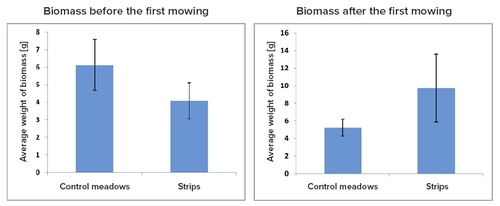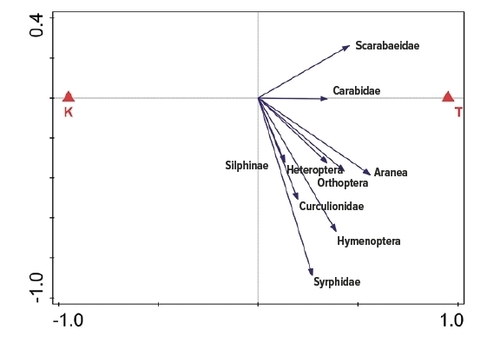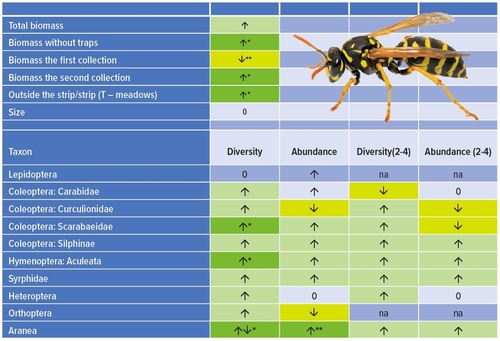The Journal is published by the Nature Conservation Agency of the Czech Republic in cooperation with the Cave Administration of the Czech Republic, the Krkonoše Mts. National Park Administration, the Bohemian Forest Mts. National Park Administration, the Podyjí National Park Administration and the The Bohemian Switzerland National Park Administration. It has been published since 1946.
cs / en
Nature Conservation 2022 — 25. 5. 2022 — Research, Surveys and Data Management — Print article in pdf
Temporarily Unmown Grass Strips – A Hope for Productive Meadow Insects?
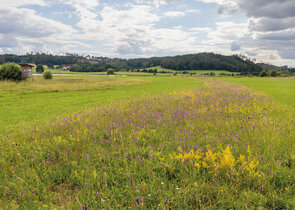
The agri-environmental-climate measures (AECM) announced by the Ministry of Agriculture of the Czech Republic are intended to support management methods mitigating the negative effects of intensive farming on the landscape and its inhabitants, including insects. Despite their productive nature, permanent grasslands are an important landscape component hosting a wide range of invertebrates. The right balance of production practices and compensatory measures can make a significant contribution to maintaining the diversity of grassland organisms and the ecosystem services they provide. The Nature Conservation Agency of the Czech Republic (NCA CR) has therefore commissioned a study on the effects of temporarily unmown grass strips on the diversity and abundance of meadow organisms. The aim of the study was to verify whether the retained parts of grass stands have a positive effect on the biota on common managed meadows of various sizes.
The decline in insect populations has long been connected only with species associated with threatened habitats. Recently, the phenomenon of global insect decline and loss has come to the forefront of the interest of professionals and the general public (Hallmann et al. 2017, SánchezBayo & Wyckhuys 2019, Seibold et al. 2019). Although there has still been debate about the extent to which these “alarmist” reports are data-based (e.g. Didham et al. 2019, Wagner 2019), the “insect-clearing” of the landscape seems to be a real phenomenon and the decline also affects the hitherto abundant and common species of the cultural landscape (Basset & Lamarre 2019, Habel & Schmitt 2018, Harvey et al. 2020, Wagner 2020, Hallmann et al. 2021). There are many reasons for the decline in and loss of insects, including some economically valuable and irreplaceable pollinators: habitat loss, chemical and light pollution, climate change, as well as new and invasive alien species. In Central Europe, how- ever, it is necessary to look for causes mainly in the structure of the landscape and the way it is used. One of the main threatening factors/ drivers is the unification of the environment due to industrial use of the landscape.
Apart from pastures, the most important insect habitats in the agricultural landscape are mainly permanent grasslands for hay production. These meadows are harvested by machine, two to three times a year (depending on climatic conditions), while the mowing dates are set by a government decree and are linked to the payment of subsidies. One-off machine mowing has an impact on insects in several ways. Almost everyone will immediately think of bees, bumblebees, and butterflies that lose their food. In the case of mobile species, it may not be so bad; the Western honeybee (Apis mellifera) will simply look for another source of food. Small solitary bees, often tied to specific plant species as a source, are significantly worse off. For their offspring, mowing the meadow is basically an existential question, as in a few hours, their home becomes literally a green desert. Butterfly caterpillars are in a similar situation. For this reason, the Danube clouded yellow (Colias myrmidone) has relatively recently become extinct in the Czech Republic. In addition, machine mowing also directly kills invertebrates. One mowing of a meadow kills 40% of locusts and grasshop- pers, another 40% is killed by baling hay. A direct link between mowing type and population size was demonstrated on the last surviving population of the Larger saw-tailed bush cricket (Polysarcus denticauda) in the Jičín region, which was momentarily resurrected by the diversification of the mowing regime before the farm concerned returned to its original management model due to administrative barriers (e.g. Konvička et al. 2008, Humbert et al. 2010, Marhoul 2012).
Although most Central European grassland communities have been converted to productive agroecosystems, their importance for preserving global biodiversity and ecosystem functions within the landscape cannot be underestimated. Current grassland ecosystems are substitute habitats for now extinct Central European savannah species (Dostál et al. 2014). In addition, over the centuries of specific management, unique ecosystems have emerged which can also be surprisingly very species-rich (Batáry et al. 2007). At present, the grassland ecosystems of temperate zones are among the most endangered biomes in the world (Habel et al. 2013, Tökök et al. 2016) which logically also applies to their inhabitants (e.g. Reif et al. 2008, Van Swaay & Warren 1999, Franzén & Johannesson 2007, Wagner et al. 2021).
How did the research proceed?
The actual implementation of the study took place on the basis of an assignment created in cooperation between the NCA CR and the Ministry of the Environment of the Czech Republic. A total of 100 research plots were used located on 22 farm meadows in the so-called open landscape area near the Český ráj/ Bohemian Paradise Protected Landscape Area.
The meadows were selected according to the assignment from three different size categories: meadows with an area of 1–5 ha, meadows with an area of 5–12 ha, and meadows with an area of more than 12 ha. Half (11) of the meadows were experimental, i.e. strip mowing was introduced there, leaving approximately 5–10% of the area unmown (Fig. 2). The other half (11) was mown in the classic blanket manner. Each plot consisted of a set of three types of traps designed to capture invertebrates. Specifically, it was one window trap measuring 1.5 × 1 m, three ground traps (plastic cup with a volume of 500 ml) with fixation, and ten 200 ml yellow cups to catch pollinators. Due to the vegetation, yellow traps were always placed on wooden poles 1 m high. The collections themselves were always made before mowing and a week after mowing on each meadow, thanks to which it was possible to evaluate the effect of mowing on meadow invertebrate communities. A total of four collections were carried out, the first in May and the last at the turn of August and September after the second hay harvest. All material was fixed in 75% ethanol at collection. Diurnal butterflies were monitored twice a season by the transect method (observation per unit of time) in sunny and wind-free weather. All material thus collected was subsequently weighed in the alcohol state on analytical balances, according to the methodology given in Hallman et al. (2017). Subsequently, species were determined in nine selected groups of invertebrates: ground beetles (Carabidae); scavengers (Silphidae); scarab beetles (Scarabaeidae); weevils (Curculionidae); stinging bees and wasps (Hymenoptera: Aculeata), true bugs (Heteroptera); hoverflies (Syrphidae); grasshoppers, locusts, and crickets (Orthoptera); diurnal butterflies (Lepidoptera: Papilionoidea); and spiders (Araneae).
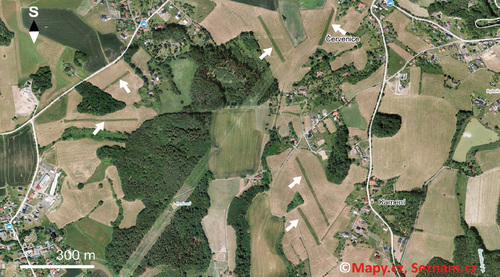
Unmown grass strips (marked by an arrow) can also be an important landscape feature. Agricultural landscape near the village of Vlastibořice (District of Turnov), photo from June 2019. Source: Mapy.cz, Seznam.cz
Amount of biomass captured on control meadows and meadows with strips before and after the first mowing. © Tomáš Jor
RDA ordination diagram showing the relationship of the studied groups to meadows with strips (T) or without strips (K). The direction of the arrow shows the preferred environment, the length of the arrow the strength of the preference. © Tomáš Jor
Summary of study results: changes in collected biomass, species richness, and abundance of groups depending on the type of mowing in the first year of research. © Tomáš Jor
The last two collections were excluded from analyses of the meadow strip effect on invertebrate biomass, as 2018 was very dry and the meadows turned into “yellow (no longer green) deserts” after mid-July, which had a major impact on the biodiversity of captured organisms.
The main reason was that the vegetation was largely non-grown on a large part of the meadows and it was difficult to judge from these data whether the weather or the type of mowing had a greater effect. However, data from all collections were included in species diversity analyses to determine the cumulative effect of unmown strips on invertebrates.
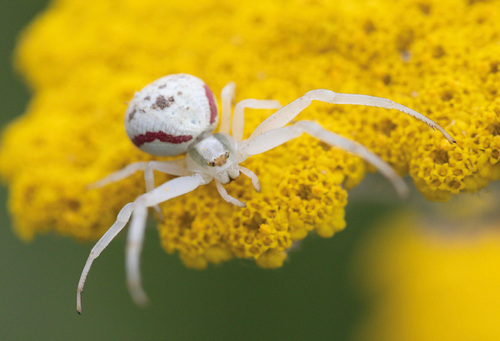
Machine mowing has a negative effect on spiders as well (Goldenrod crab spider Misumena vatia). © Petr Šípek
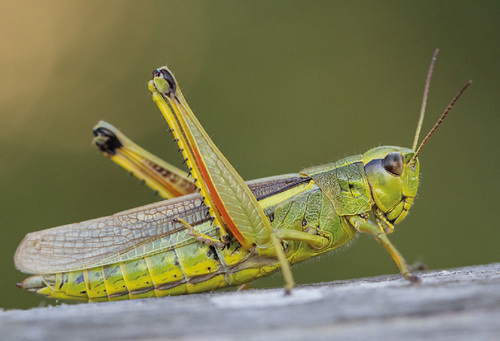
Machine mowing also endangers grasshoppers, locusts, and crickets (Large marsh grasshopper Stethophyma grossum). © Petr Šípek
What are the results?
Based on the analysis of the total collected biomass of insects and arachnids, it is clear that the strips have a clear positive effect on the number of captured invertebrates. In the first collection, there is a statistically significant higher amount of biomass in the control meadows (Wilcoxon test, p = 0.00397). However, after the first mowing in 2018, the situation changed dramatically. Suddenly, more invertebrates were collected in the meadows with strips (Wilcoxon test, p = 0.00695).
The fact that the strips served as islands of life in the production meadows in the first year of the project is also evidenced by the evidence that the biomass of invertebrates captured on the experimental areas located in the strips was significantly higher than that obtained in the same meadows in traps outside the strip. The effect of the strips was also independent of the experimental meadow size. The strip-mown meadows were not only richer in total number of individuals (biomass), but also in that of captured species (species richness). Individual monitored groups entered the RDA (redundancy analysis) and instead of the traditionally used abundance, total number of species in the studied meadows was used there. The model testing the effect of unmown strips resulted in a clearly positive effect on the number of species for meadows mown in parts.
It is obvious that all the monitored groups have a greater relationship to the experimental strip meadows. However, from the dispersion of individual vectors on the second (vertical) axis of the diagram, it is clear that the overall biodiversity of invertebrates is affected by many other factors (humidity, isolation, herb richness, etc.).
The complete results are summarized in the following table (Table), which shows both the overall results concerning the analyses of captured biomass and also those describing the identified diversity and abundance for individual studied groups. In the year that management was introduced, the unequivocally positive effect of strip mowing on diversity was found with scarab beetles, bees and wasps, and spiders. Moreover, a strong positive effect of strips on the number of individuals was also recorded in spiders. Like all biological systems, meadow (agro-) ecosystems are very complex and comprehensive, as demonstrated by the de- creases in abundance of some groups in the experimental plots.
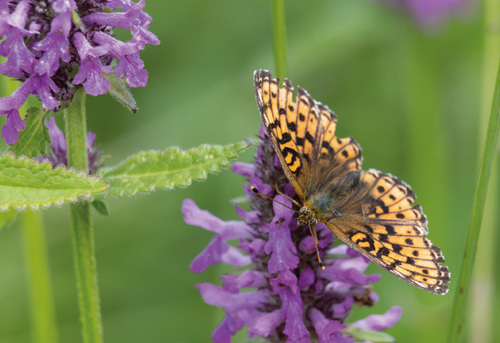
Heath fritillary (Melitaea athalia) sucks on betony (Betonica officinalis). © Petr Šípek
What to say in conclusion?
If we look at almost any literature focused on invertebrate diversity in the production/working landscape today, we will find that everything is not quite right. This is mainly due to a significant change in landscape management over the last 100 years. Due to agriculture, diversity has disappeared from the landscape. In the past, there were dozens of various patches of land belonging to different owners on a few hectares that formed a diverse heterogeneous landscape mosaic; after the merging of land parcels/plots, we no longer find such a mosaic. Thanks to landscape diversity, even in a managed landscape, the organisms still had the opportunity to move to places that were relatively suitable for them. Also, there used to be a difference in the speed of individual agricultural activities. What a farmer did with the scythe for half a week, today the tractor can do it in less than two hours and on an even larger area. This fact radically affects meadow communities, and we should take a certain moral obligation to support these organisms.
From the results presented above, it is quite clear that the maintained meadow strips could be the method that will help improve the situation of invertebrates in the open landscape, similarly to Specially Protected Areas (see the study from the Babiččino údolí/Grandmother’s Valley National Nature Monument Čížek et al. 2012). Their positive effect manifested itself in the very first year of mowing adjustment. They provide animals with an indispensable source of food, even when mowing the remaining part of the meadow. The strips also very often create a missing refuge in which organisms can hide from bad weather. In many insect species, the role of such a refuge is even more crucial for larval development; for example, due to the relatively large impact of mowing on the microclimate at a site, which is absolutely essential for the development of, e.g. many species of caterpillars. Radical changes usually have a lethal effect on them. A very important factor is also that unmown strips are a relatively easy and cheap method. At present, according to AECM rules, the retained strips are only mandatory for meadows with a size of more than 12 hectares; due to the negative trend in insect populations, it is necessary to extend this measure to smaller areas as well.
Management recommendations within AECM
If we could choose, we would recommend promoting such way of management that would lead to the spread of strip refuges in the landscape, regardless of meadow size. It is important that unmown areas are in the form of strips and that the strips are maintained to the greatest extent, even during the winter.
As with other biodiversity-supporting measures, it is clear that there is no universal solution. In order to maximize the effectiveness of the measures, it would be necessary to support diversity in the location of strips (both in the middle and on the edges) which, on the other hand, may not be readily accepted by agricultural entities/enterprises and control bodies, such as the State Agricultural Intervention Fund (SAIF). One solution could be an expansion of the subsidy according to the degree of heterogeneity of the implemented measures (e.g. such as in Switzerland). At the same time, however, AECM must not increase the administrative burden on the stakeholders concerned. ■
- - -
Intro photo: Herb-rich unmown strip. © Petr Šípek
- - -
List of referencies
Basset, Y., Lamarre, G.P.A., 2019. Toward a world that values insects. Science 364, 1230–1231. https://doi.org/10.1126/science.aaw7071
Batáry, P., Báldi, A., Szél, G., Podlussány, A., Rozner, I., Erdős, S., 2007. Responses of grassland specialist and generalist beetles to management and landscape complexity. Diversity and Distributions 13, 196–202. https://doi.org/10.1111/j.1472-4642.2006.00309.x
Cizek, O., Zamecnik, J., Tropek, R., Kocarek, P., Konvicka, M., 2012. Diversification of mowing regime increases arthropods diversity in species-poor cultural hay meadows. J Insect Conserv 16, 215–226. https://doi.org/10.1007/s10841-011-9407-6
Didham, R.K., Basset, Y., Collins, C.M., Leather, S.R., Littlewood, N.A., Menz, M.H.M., Müller, J., Packer, L., Saunders, M.E., Schönrogge, K., Stewart, A.J.A., Yanoviak, S.P., Hassall, C., 2020. Interpreting insect declines: seven challenges and a way forward. Insect Conservation and Diversity 13, 103–114. https://doi.org/10.1111/icad.12408
Dostál D., Konvička M., Čížek L., Šálek M., Robovský J., Hořičková E. Jirků M. 2014. Divoký kůň (Equus ferus) a pratur (Bos primigenius): Klíčové druhy pro formování české krajiny. Česká krajina o.p.s. http://www.ceska-krajina.cz/wp-content/uploads/2015/01/Dostal-et-al_2014_Divoky_kun_a_pratur_Studie_Equus_Ferus_Bos_primigenius.pdf
Franzén M., Johannesson M. 2007. Predicting extinction risk of butterflies and moths (Macrolepidoptera) from distribution patterns and species characteristics. Journal of Insect Conservation 11, 4: 367–390.
Habel J. C., Schmitt T. 2018. Vanishing of the common species: Empty habitats and the role of genetic diversity. Biological Conservation 218: 211–216. https://doi.org/10.1016/j.biocon.2017.12.018
Hallmann, C. A., Sorg, M., Jongejans, E., Siepel, H., Hofland, N., Schwan, H., Stenmans W., Müller A., Sumser H., Hören T., Goulson D., de Kroon, H. 2017. More than 75 percent decline over 27 years in total flying insect biomass in protected areas. PloS one, 12(10), e0185809


